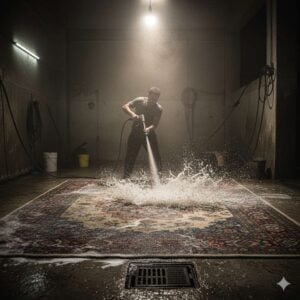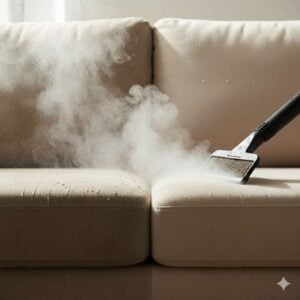Mold in your home isn’t just an inconvenience; it’s a health concern that needs immediate attention. Especially in the UAE, where the warm climate can encourage mold to grow quickly, understanding how to deal with this problem effectively is crucial. This guide will take you through five key steps to thoroughly do mold remediation and maintain a clean, safe living environment. These steps are designed to be effective and straightforward, ensuring that you can tackle mold issues with confidence. Let’s begin this journey to a healthier, mold-free home.
[lwptoc]
Table of Contents
Toggle1. Initial Inspection and Mold Assessment
The journey to effective mold remediation starts with a thorough initial inspection and mold assessment. This critical first step is about understanding the extent and type of mold problem you’re facing. It involves a detailed examination of your property to identify visible signs of mold, which might appear as patches on walls, ceilings, or hidden behind furniture. The aim is to pinpoint all the areas where mold is present, including those that are not immediately obvious.
During this phase, it’s also essential to identify the sources of moisture that are contributing to mold growth. Mold thrives in damp conditions, so finding and addressing sources of water leakage or condensation is crucial for successful remediation. This could involve checking for leaks in roofs, pipes, or windows, or addressing high humidity levels within the home.
Understanding the type of mold is another vital aspect of the assessment. Different mold types can have different implications for health and property. For instance, black mold is known to pose more significant health risks and requires specific remediation strategies. Therefore, accurately identifying the mold type is fundamental to determining the appropriate course of action for removal and prevention.
Air quality testing is another essential component of the initial assessment. Mold can release spores into the air, which can be harmful when inhaled. Professional air testing can determine the concentration of mold spores and the level of contamination in your home. This information is critical for planning the remediation process, ensuring that the air quality is safe post-remediation.
The initial inspection and assessment phase should conclude with a comprehensive report. This report outlines the findings, including the extent of the mold problem, the identified sources of moisture, the types of mold present, and the air quality assessment. This report forms the basis for the remediation plan, guiding the subsequent steps in the process.
In summary, the initial inspection and mold assessment are about gaining a complete understanding of the mold issue at hand. It’s a detailed process that looks beyond just the visible signs of mold, delving into the underlying causes and potential health implications. This step is essential for crafting an effective and targeted mold remediation strategy. For more insights on handling mold damage, refer to this informative article on critical signs of mold damage and how to address them.
2. Containment of the Affected Area
Once the initial inspection and assessment are complete, the next crucial step in mold remediation is the containment of the affected area. This step is vital to prevent the spread of mold spores to other parts of the home or building, thereby containing the problem and preventing further contamination.
Containment typically involves sectioning off the mold-affected area from the rest of the property. This is achieved using plastic sheeting and specialized tape to seal doors, windows, and any other openings. The goal is to create a physical barrier that traps mold spores within the affected area. This isolation is essential for keeping the rest of the property safe while the remediation process is underway.
In addition to physical barriers, Bio-On often employs negative air pressure systems within the contained space. This technology involves using air scrubbers or negative air machines, which work to filter out mold spores from the air inside the containment. By creating a negative air pressure environment, any loosened spores are sucked into air filtration systems rather than being allowed to spread into uncontaminated areas. This method is particularly effective and is a standard practice in professional mold remediation.
Another important aspect of containment is ensuring that the mold does not spread during the remediation process itself. This involves the use of proper personal protective equipment (PPE) by the remediation team, as well as specific protocols for entering and leaving the contained area. These procedures are crucial for preventing the accidental transport of mold spores outside the containment zone on clothing or equipment.
The containment stage is not just about immediate containment; it’s also a preparatory step for the actual removal of the mold. By securing the area, the team ensures that the mold removal process can be conducted safely, efficiently, and without risk of contaminating other parts of the building.
Effective containment requires expertise and the right equipment. It is a critical component of the mold remediation process, ensuring that the problem is controlled and contained right from the start.
In conclusion, containment of the affected area is a decisive and proactive approach in mold remediation. It sets the stage for safe and effective mold removal, ensuring that the remediation process does not exacerbate the problem but instead resolves it in a controlled and efficient manner.
3. Air Filtration and Mold Spore Removal
After successfully containing the affected area, the next crucial step in mold remediation is air filtration and mold spore removal. This phase is essential for purifying the air within the contained space and is pivotal in ensuring that the environment is safe and healthy.
Air filtration involves using specialized equipment to capture and remove mold spores from the air. High-Efficiency Particulate Air (HEPA) filters are typically used in this process due to their ability to trap particles as small as 0.3 microns. Mold spores, which can be a few microns in size, are effectively captured by these filters. Air scrubbers equipped with HEPA filters are placed within the contained area to continuously filter the air, capturing airborne mold spores that might have been disturbed during the remediation process.
In addition to air scrubbers, other air filtration devices like negative air machines may be used. These machines create a negative air pressure environment, which helps prevent the spread of mold spores to other areas. By directing the airflow outside the containment area, these machines ensure that the majority of spores are removed from the indoor environment.
Mold spore removal is not only about cleaning the air; it also involves addressing surfaces where spores may have settled. Surfaces within the contained area are thoroughly cleaned and sanitized. This includes floors, walls, and any other surfaces that might have come into contact with mold spores. Using antimicrobial agents and disinfectants, Bio-On ensures that these surfaces are not just visibly clean but are also free from mold spores and other contaminants.
The process of air filtration and mold spore removal is a careful and methodical one. It requires constant monitoring to ensure that air quality levels are maintained and that the environment is safe for inhabitants. Bio-On’s team of experts uses various tools to measure air quality, including mold spore counts, to ensure that the air is indeed clean before moving to the next step of the remediation process.
This phase is vital in the overall mold remediation process as it addresses one of the primary health concerns associated with mold – the inhalation of mold spores. For those particularly sensitive to mold, this step is critical in ensuring their health and safety. To understand more about the health implications of mold and the importance of air quality, Bio-On’s article on black mold remediation techniques offers valuable insights.
In summary, air filtration and mold spore removal are about creating a safe and clean air environment within the contained area. Through the use of advanced filtration technology and meticulous cleaning practices, Bio-On ensures that the air is free from harmful mold spores, paving the way for the next steps in the mold remediation process.
4. Mold Removal and Cleanup Procedures
Following the containment and air filtration stages, the next critical step in mold remediation is the actual removal of the mold and the cleanup of the affected area. This phase is where the visible mold infestation is physically removed, and the area is thoroughly cleaned and sanitized.
Mold removal begins with the careful extraction of mold from all infected surfaces. This can include walls, ceilings, flooring, and even personal belongings, depending on the extent of the infestation. Bio-On utilizes specialized tools and techniques to remove mold effectively. This often involves scrubbing surfaces with antimicrobial agents that are designed to kill mold and prevent its return. It’s important to note that simply using bleach is not sufficient, as it may not penetrate deeply enough to remove all mold roots, and it does not prevent future growth.
The cleanup process is just as crucial as the removal itself. After the mold is physically removed, the area must be thoroughly cleaned to ensure that no spores remain. This includes cleaning not just the affected areas, but also nearby surfaces and materials to ensure complete eradication. Vacuuming with HEPA-filtered vacuums is a common practice, as it ensures that even the smallest spores are captured and removed.
In addition to cleaning the physical surfaces, it’s also vital to address any items that have been affected by mold. This can include furniture, curtains, and even clothing. Bio-On advises on the best methods to clean and restore these items or, in severe cases, may recommend disposal to prevent cross-contamination.
Bio-On’s mold removal and cleanup procedures are designed to be comprehensive. They not only address the current mold issue but also help to prevent future outbreaks. For instance, after cleaning, Bio-On may apply mold-inhibiting agents to the affected areas to create an environment where mold is less likely to grow. After the mold has been removed and the area cleaned, it’s crucial to verify that the space is mold-free. This may involve further air quality tests to ensure that all mold spores have been effectively removed from the environment. The goal is to restore the area to a safe, healthy state, free from any mold contamination.
In conclusion, mold removal and cleanup procedures are essential steps in the remediation process. They require meticulous attention to detail and the use of professional-grade products and techniques. This thorough approach ensures that the mold issue is resolved effectively, providing a safe and clean environment for the inhabitants.
5. Repair and Prevention Strategies
The final step in mold remediation is focused on repair and prevention strategies. After removing the mold and thoroughly cleaning the affected area, it’s essential to repair any damage caused by the mold and implement measures to prevent future mold growth.
- Repairing Mold Damage: Mold can cause significant damage to building materials and personal items. The repair process may involve replacing or restoring damaged drywall, flooring, and other structural elements. In some cases, it could also mean repairing the sources of moisture that contributed to the mold growth, such as fixing leaky pipes or damaged roofing. This restoration not only brings the affected area back to its original state but also ensures that it’s safe and healthy for occupants.
- Moisture Control: Controlling moisture is the key to preventing mold growth. Bio-On advises on strategies to reduce indoor humidity, such as using dehumidifiers, improving ventilation, and ensuring proper insulation. In areas like bathrooms and kitchens where moisture is prevalent, it’s important to use exhaust fans and keep surfaces dry. Addressing condensation on windows and pipes can also help in reducing moisture levels in the home.
- Improving Airflow and Ventilation: Proper ventilation is crucial in preventing mold. Ensuring that air circulates freely throughout the home can help in controlling moisture levels. Bio-On may recommend solutions like opening windows regularly, using ceiling fans, and ensuring that vents are not blocked by furniture or curtains.
- Regular Maintenance and Inspection: Regular home maintenance is important in preventing mold. This includes routinely checking for leaks, keeping gutters clean, and ensuring that the ground slopes away from the foundation to prevent water accumulation. Bio-On suggests periodic inspections of the home to identify potential mold issues before they become significant problems.
- Using Mold-Resistant Products: For areas prone to moisture, using mold-resistant products can be a wise choice. This can include mold-resistant drywall, paints, and primers. These products can be particularly beneficial in high-humidity areas like bathrooms and basements.
- Education and Awareness: Finally, educating homeowners about the signs of mold and the conditions that promote its growth is crucial for prevention. Being aware of the common indicators of mold, such as musty odors or visible mold growth, can help in taking early action to prevent widespread contamination.
Why Our Expertise at Bio-On is Essential for Successful Mold Remediation
Tackling mold remediation effectively demands the expertise and experience that our team at Bio-On provides. This task is far more complex than just cleaning visible mold; it involves a detailed process that includes identifying the problem’s source, containing the spread, and ensuring complete removal and prevention. Such precision and meticulous care are hallmarks of our trained professionals at Bio-On.
At Bio-On, our approach to mold remediation is comprehensive. We are equipped with specialized tools and possess the knowledge needed to handle a variety of mold situations. From the initial inspection to the final repair and prevention steps, we ensure that every phase is executed with utmost attention to detail. This includes employing advanced techniques for air filtration, effective containment strategies, and the latest methods in mold removal and cleanup.
Our commitment at Bio-On extends beyond resolving immediate mold issues. We place a high value on educating our clients and providing ongoing support. This approach not only addresses current mold problems but also arms our clients with the knowledge and strategies needed to prevent future occurrences.
Choosing Bio-On for mold remediation means investing in a comprehensive, long-term solution that prioritizes the health and safety of your environment. For more insights into the critical role of professional mold remediation services, we invite you to read about our mold remediation services. With Bio-On, you’re not just getting a service; you’re ensuring a safer, healthier living or working space.
Conclusion
In conclusion, mold remediation is a meticulous and multifaceted process, demanding expertise at every turn. Each step, from the initial inspection and containment to the final removal and prevention, plays a pivotal role in ensuring a successful outcome. At Bio-On, our dedicated professionals are committed to delivering comprehensive, effective solutions for mold challenges. By choosing our expert services, you are not just addressing the immediate issue but also investing in long-term prevention. Trust Bio-On to restore and maintain a healthy, safe environment in your home or business, safeguarding your space against the risks and recurrences of mold.













